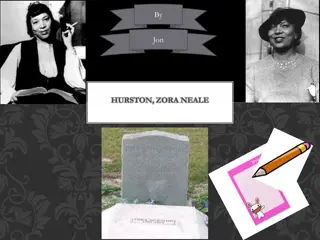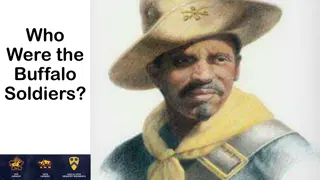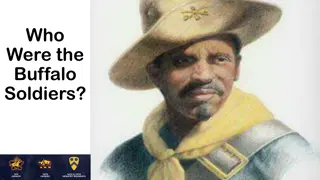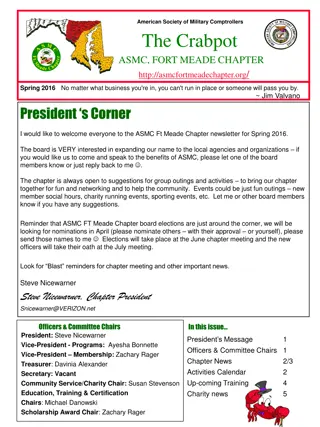
American History: Economic Revolution, Changing Population, Transportation & Technology
Explore the economic revolution in America, changes in population between 1820 and 1840, nativism sentiments, advancements in transportation, communications, and technology from canals to railroads, and the growth of corporations and industry in the 19th century.
Uploaded on | 0 Views
Download Presentation

Please find below an Image/Link to download the presentation.
The content on the website is provided AS IS for your information and personal use only. It may not be sold, licensed, or shared on other websites without obtaining consent from the author. If you encounter any issues during the download, it is possible that the publisher has removed the file from their server.
You are allowed to download the files provided on this website for personal or commercial use, subject to the condition that they are used lawfully. All files are the property of their respective owners.
The content on the website is provided AS IS for your information and personal use only. It may not be sold, licensed, or shared on other websites without obtaining consent from the author.
E N D
Presentation Transcript
www.Apushreview.com American History: Chapter 10 Review Video AMERICA S ECONOMIC REVOLUTION
The Changing American Population Between 1820 and 1840, the population drastically increased Faster rate than Europe Immigration: increased rapidly during and after 1830s Most settled in urban areas of the Northeast Highest numbers came from Germany and Ireland Germans: Tended to move to the Northwest farmers (Cincinnati!) Irish: Potato famine, move to cities
The Changing American Population Cont. Nativism: Distrust and dislike of foreigners; favoring Native-born Americans Wanted to stop or slow the influx of immigrants Reasons for Nativism: Immigrants would work for lower wages Belief that immigrants were destroying America and its culture Fear of the Catholic Church and Pope Stealing votes Examples of Nativism: Supreme Order of the Star-Spangled Banner ( Know-Nothings or the American Party) NINA
Transportation, Communications, And Technology 1820s saw an increase in canals NY Erie Canal: 363 miles, Albany to Buffalo Clinton s Big Ditch Built by Irish Paddies Gave NYC access to Chicago Canals also stimulated settlement in the Northwest Railroads: Baltimore and Ohio - 1830 Problems with early railroads? Different gauges on tracks Frequent accidents and erratic schedules
Transportation, Communications, And Technology Cont. 1850s saw a huge increase in railroad development Trunk Lines shorter lines consolidated into longer lines Helped decrease importance of canals Funding for railroads: State, local and federal governments State and local through $ Federal through land grants Most railroads were located in the Northeast Further disconnected the North and South Morse Code: James K. Polk s nomination for the Democratic Party in 1844
Commerce and Industry Growth of corporations: Increased in 1830s which made them possible by paying a fee Limited Liability: Stockholders would only lose value of stock if the corporation failed Technological advances: Interchangeable parts Eli Whitney Used for bicycles, sewing machines, typewriters, etc. Charles Goodyear: Rubber Elias Howe and Isaac Singer: Sewing machine Use of coal: Allowed factories to move away from water Cities began to grow to mine coal (Pittsburgh)
Men and Women at Work Advancements in transportation allowed farmers to ship goods to all regions of the country Leads to an increase in specialization of industry Lowell System Young, single women (farmers daughters) would work in a factory Boardinghouses for workers, curfews, churches High wages Why did the Lowell System decline? Panic of 1837 hurt wages Increase in immigrants that worked for less
Men and Women at Work Cont. Construction Gangs of immigrants helped build the infrastructure Immigration helped lead to a decrease in working conditions Many Americans were not concerned with conditions for immigrants Early unions: Skilled craftsmen unions Common law viewed most early unions as an illegal conspiracy Commonwealth v. Hunt (1842): Massachusetts Supreme Court case that stated unions were legal Other states soon agreed Unions did not gain more power until the late 19th century
Men and Women at Work Cont. Women were not included in unions Free Labor Northern workers viewed freedom as an absence of slavery Northern workers disliked slavery for two reasons: Lack of freedom Took away jobs Free African Americans had little freedom as well Not considered legal citizens
Patterns of Industrial Society Economic growth not shared equally: Slaves, Native Americans, unskilled workers were left out Urban areas saw high poverty rates Many were immigrants and often homeless Free blacks in the North faced severe difficulties: Could not: Vote Attend public schools Use public services Geographic Mobility: Safety-valve theory Frederick Jackson Turner: In times of economic crisis, Americans could always move west to the frontier
Patterns of Industrial Society Cont. Men and women had increasingly different social roles Women could almost never obtain a divorce Cult of Domesticity : Women and men had separate spheres Women were encouraged to stay home and raise children and instill moral values Single women did not have many occupational choices: Teachers, nurses, and domestic servants
The Agricultural North Old Northwest (OH, IL) specialized in meatpacking Cincinnati! (Porkopolis) Chicago Specialization in Agriculture: West: Livestock and dairy South: Cashcrops North and Mid-Atlantic wheat, fruits, and vegetables Agricultural inventions: John Deere: steel plow Cyrus McCormick mechanical reaper Helped with harvesting wheat Rural Life: Church played a large role brought the community together
Thanks for watching! Subscribe to my channel Help spread the word Questions? Comments? Ideas for videos? Leave in comments Go Reds!






















